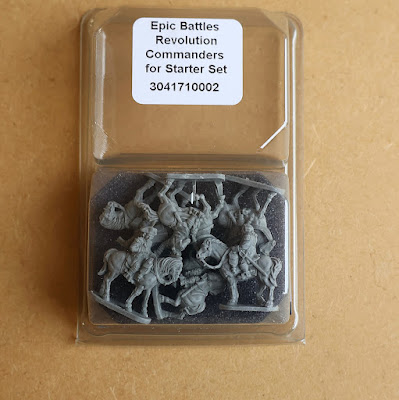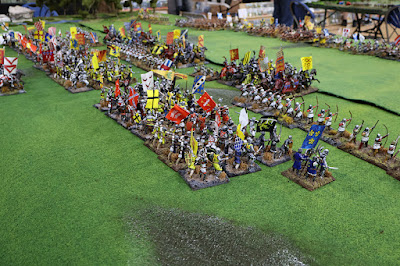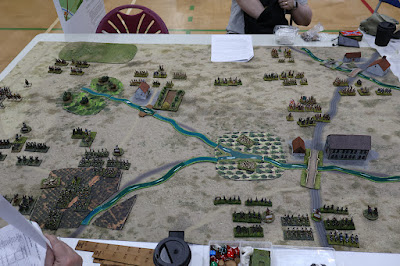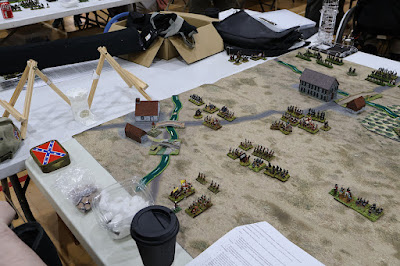Another instalment in Warlord Games’ Epic series has just been released … Epic Revolution, covering the American War of Independence. I picked my battle set up at the Phalanx Wargame show.
I have not had the chance to take a proper deep dive into the bundle and by now there will already be a lot of ‘out of the box’ type posts, especially on YouTube, that will serve you much better than can be done here, especially by those that have a more intimate understanding of the period …. So what follows are just some initial thoughts on where I might take this.
I got the £160 Battle Box and generally everything about it fits the formulaic approach that we have seen so far in the Epic line-up.
For those not familiar with the format, you get over 2000 figures covering the British and their Hessian and Native American Allies and the American Continental Army. The infantry are in standard strips of 10 and double ranked will fit the supplied 60mm x 20mm plastic bases. The rulebook is an A5 version of Black Powder II, with all references and artwork to other periods removed and replaced with AWI specific content. Additionally you get an MDF piece of terrain (watchtower), a pack of commanders, produced in the ‘Warlord Resin’ (Cornwallis, Tarleton, Howe, Riedesel, Gates & Morgan - below photo) and a flag sheet.
For those who are familiar, the differences in this box are that the inclusion of the commanders is a nice touch as in previous starter sets, these have been sold separately. The flags are larger and have been printed on heavier coated paper. The infantry command strip (see below) has a space caused by a missing figure. Two single figures are supplied, a flag carrier and a standard line infantry man, it is for you to choose which of those two figures you glue into that space. This is a great idea to increase the functionality of the sprue, so the gamer can now have double flagged or single flagged command bases as historically appropriate.
The bases sprue has for the first time since the series launched, been re-configured. It is now simply a bit longer with four extra infantry bases (60mm x 20mm) on it. This makes a lot of sense from a packaging point of view as the frames are now a better fit for the box, plus they will need fewer base frames overall.
Figures and bases - the sculpting on the figures is nice and sharp and the cavalry that have previously been criticised for lacking detail on the front and back of the rider, is now more detailed. It looks like to do this, they have gone with turning the rider in the saddle to the side so that chest and back are actually caught in the side-on profile, which due to the production methods is exactly where the detail can be added.
I find that one area of weakness of every Epic release so far is that you don’t get a flysheet that tells you exactly what’s on each sprue. You end up looking at the sprue and then checking through the rules and looking at photographs or internet posts to make sure that have properly identified the figure type. It is similar here, I am not overly familiar with the period, so I read through the rules text to find out which unit types might be double flagged …. I couldn’t find anything (unless I have missed it!) within the package, in the end I relied upon the photographs in the rules, which I assume to be right!
The system continues the Epic trend within the Horse & Musket period of bases being 60mm wide with a standard unit for (say) British line comprising of four bases, so a typical line unit would have a frontage of 240mm. As before, notably different sized units have their base numbers adjusted, so a large unit has five bases and a small unit three. There are quite a few units described as ‘tiny’ for example cavalry and they are down to one base.
In my previous Epic endeavours, I have generally gone for fewer bases in a unit, this helps with my table size and also cuts down on the amount of things that need painting. I have come to settle on three bases looking pleasing on the table and this works for my collections with the smaller battles and in bigger games that have more demand on the collection, dropping to two base units works fine …. It can look a bit mean compared to three bases, but it works. Also, I prefer to sit the figures on a 55mm MDF base to cut down that inherent gap that you visually get along the line due to roughly 55mm blocks of infantry sitting on a 60mm base.
Of interest is the way that the figure sprues are populated, so here you don’t end up for example with a load of cannons simply because there was one on every infantry sprue.
Rules - the box comes with the small A5 format Black Powder based rules that we have all become used to getting with each Epic release. They hold the basic rules of Black Powder II, but all picture content, support material and wordage is made specifically to accommodate Epic American War of Independence.
I already have the rather marvellous ‘Rebellion’ Black Powder supplement and it is clear that large chunks of that tried and tested text have been lifted and placed into the Epic rulebook, which is a benefit that makes the rulebook feel quite holistic in its approach as it covers so much - a lot of work has gone into this rule set to make it AWI specific - well done that team.
We get leader and unit profiles, a bit of general history, some specific unit histories and historical scenarios, all in 255 pages, really this can be considered a one-stop gaming source for the average gamer.
I know not everyone likes Black Powder rules, with the detractors mainly not liking that some units can hang around for several turns without activating, also not liking the generic nature of the rules. However, I quite like the chaos that comes from the potential lack of activation, where the hand of restraint rest upon the gamer, who without such restraint sees everything with a birds eye view and might want to react instantly with some sort of panzerblitz style ability! It injects moments of anticipation into the game as the command dice are rolled. Also, the rule is tempered by allowing automatic activations for being within close proximity of the enemy, so the chaos is more about the approach to battle.
As for being generic, yes, the base rules are sort of plain old Horse and Musket rules for the whole period, but it is in the adding of the differing unit characteristics and traits that open the game to more immersion and period flavour. I have my own rules for Napoleonics and ACW and while tempted to amend them to give an AWI game (within my own narrow and likely inaccurate view of military capability and tactics of the period!), I think for starters, the Epic book is so well done and everything is inter-related, that I might just go with those rules.
When using Black Powder, I generally lower the defensive value of buildings as they seem over resilient. More importantly, I take the rule from the Glory Hallelujah ACW supplement that doesn’t allow a unit to fire in the Shooting Phase if it has moved more than once in the Command Phase ….. a rule that perhaps could have been universally included in the base rules when the second edition of Black Powder came out.
I have two other period specific rulesets that look very nice. One is called ‘Live Free or Die’ by Greg Wagman and published by Little Wars TV and itself is based on Andy Callan’s old (1987) Loose Files & American Scramble set. The beauty is they are just 4 pages long and the full set comes with a load of scenarios.
The other is ‘Rebels and Patriots’ one of the Osprey Publishing ‘Blue Rules’ series. These seem very popular and don’t need many figures. The attraction here is that in the early days of building a couple of armies, one can build their forces to get an early game in with relatively few units. I always find that gaming as early as possible with a new project does encourage further painting, keeping the project alive.
The alternative rules will need me to be a bit creative in translating what a base represents and how to mark losses etc.
The Epic book includes the scenarios as listed below. They are very nicely presented with a variety of sizes of orders-of-battles, that can fit in with where you are up to with painting and collecting, though I have always been quite happy using raw unpainted figures while the army is growing - anything that keeps the enthusiasm going.
There is a clear intent that the scenarios listed should fit on a 6x4 table, but they say the bigger scenarios can enjoy an 8x4 with more room to manoeuvre. With my approach to having fewer bases per unit, I am hopeful that the domestic table will be quite adequate. They recommend that for tables under 6x4 that measurements are converted from inches to centimetres.
Of note, two of the big scenarios (Brandywine & Germantown) have their scenario orders of battle presented in what they call ‘The Grand manner’ (a feature also used in the old Rebellion supplement), so that units are typically representing brigades rather than battalions / regiments. Bath-tubbing by any other name, it does get the full action onto the standard sized table.
The scenarios provided are;
Bunker Hill
Chatterton’s Hill
Brandywine
Germantown
Monmouth Courthouse
Briar Creek (Georgia 3rd March 1779)
Hanging Rock
Cowpens
Guilford Courthouse
Spencer’s Ordinary (Virginia, 26th June 1781)
Finally, you get an MDF kit to build a watchtower. As with the previous Epic sets, this looks nicely done and is scaled at 15mm. My own preference for buildings in wargames is to drop a scale down, so for my Epic, I use 10mm buildings, so I am not sure what to do with this one. As a single easy build building, it might just be best to build it and use it, but the construction is very straight forward and there is a temptation to make my own scaled down version.
Having collected all the previous Epic stuff, there is a bit of a painting queue to get through, but my approach to army building now favours producing ‘Pocket Armies’ in each period, despite the ton of figures I get in each of these battle boxes. Six units to start, then going to eight and then eventually rounding out to say 12 or so units. The kind of thing that initially that fits in with the ‘One Hour Wargames’ style scenarios by Neil Thomas.
As an initial project, just to jack things up, I fancy tinkering with the three ‘throw down’ generic scenarios, Encounter Battle, Approach Battle or Meeting Engagement. These can be modified in terms of how many points you play and also the table size can be chosen to suit, so they are very scalable to whatever sized battle you want to go for.
Building two mirror forces of just four infantry units each, played on a 4´ wide x 3½´ deep table seems a great way to get the enthusiasm going to get some painted figures to the table.
The Continental force could just have 3 Continental infantry units, plus 1 Continental light unit and one commander. The British force will reflect that with 3 British line infantry and 1 British light infantry unit, plus commander.
In stage two, a gun battery and a militia unit (or two) could be added.
It might be a good time to remind ourselves that the figures come in red and blue colours, so they can be temporarily be attached to bases and initially fight in the their raw plastic state, while the painting is (or is not!) ongoing.
While a starter of 4 - 6 units would be a good leg-up to army building, I already have a bit of a fancy for getting the Bunker Hill scenario to the table. I don’t know why that is really, but a few years ago at the now defunct Phoenix wargame show (northwest UK), someone had put on a 28mm Bunker Hill game and it just pressed my ‘interest’ button. It doesn’t seem a particularly exciting situation with a line of troops advancing on a defensive position on a hill, but for whatever reason, it is just one of those game demo’s that has stayed with me, which of course is the magic of a wargame show.
Having said that, when buying the game box at the wargame show, I came across two Osprey Campaign titles, one for Guilford Courthouse and the other for Monmouth, so who knows, perhaps a slice of action or two from one of those titles might tweak the interest.
(Above) On top of that, I have the rather wonderful Illustrated Encyclopedia of Uniforms of the American War of Independence 1775 - 1783 by Lorenz Books. The detail is most excellent for 28mm painting, but it also serves to make sure the Epic colours and facings are right. It was worth buying the box set, just so that this book could be pulled from the shelves :-)
So there we are. There is a goodly amount in the box and this looks a good addition to the Epic line-up. We shall see what we shall see!
RESOURCES:
My COMMANDERS web pages are a bit more magaziney than here and in coming weeks, comments about this Epic box will be posted there.
LINK
https://commanders.simdif.com/dear_diary.html






















































